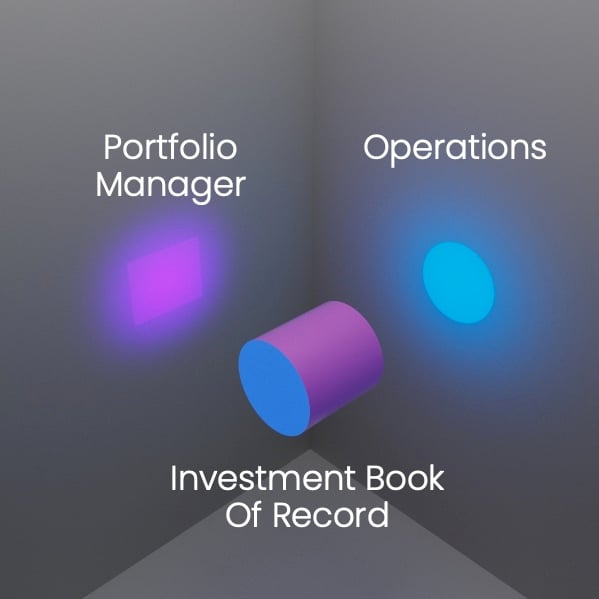
Investment Book of Record (IBOR) Definition
An Investment Book of Record (IBOR) offers an array of benefits to asset managers, but the IBOR acronym has various interpretations and use cases vary accordingly. Our goal with this article is to help you answer questions like:
- What does IBOR stand for?
- Are there multiple Investment Book of Record definitions? (short answer: yes, there are three)
- What are the benefits of the different IBORs in investment management?
For full disclosure: Part of why we started Limina back in 2014 was our recognition of the challenges in trusting and accessing position data. Hence, Limina’s Platform has a live extract IBOR core. But this post isn't a pitch for Limina or any other vendor. Rather, as former investment managers, we want to help you understand what an IBOR is and isn't: we’ve found this difficult to access to date. Hence, we created this article which is part of a complete guide to Investment Books of Record. If you want to explore how Limina compares to the Global IBOR standard, you can access the line-by-line Limina vs IBOR comparison here.
Our founder and CEO, Kristoffer Fürst, takes you through a full IBOR breakdown in the video above
What is an IBOR?
"Complete, accurate and timely position management in the front, middle and back offices"
That might sound simple, but it’s notoriously difficult to achieve in practice. Everyone who has worked with asset management systems will be familiar with arguments over the construction of positions. One user wants it one way, while another user says that this is wrong, and wants it another way. Software vendors try to please their clients, but trying to do so causes dissatisfaction for other users and clients. The one who shouts loudest (or pays the most) gets what they want, while the others must live with the result. Individual users frequently shadow and amend positions in spreadsheets to get the view they want and like. This is true whether the systems in question support accounting, compliance, portfolio and order management, execution, or risk.
Note: when discussing positions here, we mean all portfolio parts including cash, prepayments and accruals. So liabilities may be part of the picture.
Single version of truth IBOR definition
An IBOR is sometimes interpreted to mean a single version of the truth on positions. Under this interpretation, it’s a golden copy of sorts that cannot be disputed, like a definitive price or analytic. Unfortunately, it’s not that simple. Position data is inherently relativistic, and what is right or wrong, helpful or unhelpful, depends on the perspective of the consumer of the data.

To make this more tangible, below are a couple of concrete examples:
- A reconciliations clerk matching settled positions to a custodian report will not be interested in unsettled trades, let alone in unexecuted orders.
- A fund manager, on the other hand, will want to see both included in the positions that they see. If unsettled trades are not included, then the manager may well replicate orders that have already been placed, generating rework and confusion as a result.
- A fund accountant will not want to see dividends in cash positions until they reach their ex-date, while a securities lending manager will want to see dividends as much as 6 months ahead.
- A client executive will want to review positions for her clients that include known upcoming injections of cash or stock; a trade processing manager would have no use for this.
The truth is that there are many perfectly legitimate versions of the truth for position data. An IBOR sets out to deliver these diverse views of positions while maintaining strict underlying consistency.
The Best Investment Book of Records maintains that consistency by basing diverse position data on the same underlying transaction data. This is the most basic foundation of the IBOR: it shouldn’t be based on accounting snapshot alone but rather should maintain a comprehensive view of transaction data, and draw positions from that. Hence, here is what an IBOR really does:
“An IBOR creates positions from transactions, given instructions on how to do so.”
Old approaches to position management
Relying on accounting data: the flush & fill approach
You already have the second part of the Investment Book of Record definition above, "[…] position management in the front, middle and back office".
For example, if your portfolio managers use spreadsheets to monitor their positions, those spreadsheets are a form of position management. Such spreadsheets might be based on a snapshot from a batch-based “once per day” accounting system.
Another common example is a Front Office system, such as an OMS or PMS, that is populated by batch-based, so-called “start-of-day” snapshots. This is referred to in the industry as a “flush and fill” or “refresh and forget” approach. In terms of position management, we refer to it as a “Generation 1” IBOR.
Many Generation 1 IBORs try to enhance position data by adding intra-day trades (and sometimes other transactions) into the start-of-day positions, to deliver a more real-time view.

Despite this augmentation, the start-of-day data load approach doesn’t give a complete and real-time position view. Common problems include missing data intraday, such as predictable cash transactions (custody fees, audit fees etc) as well as one-off cash transactions. The latter include cash injections from clients (deposits), as well as liquidation proceeds, class action damages etc. In-specie transfers are often missed too, so it's not all about cash.
There are two additional significant drawbacks with a flush and refresh approach to position management in the Front and Middle office:
- A Generation 1 IBOR struggles to support future projections, e.g. future corporate action impacts on exposures.
- The Generation 1 IBOR can’t be used for duality and reconciliation purposes, because it is based on incomplete data. This is amply demonstrated by the flushing (and therefore junking) of the position data each day, and the continuing dependence on the manager’s accounting system.
A modern IBOR can in many cases obviate the need for a traditional in-house accounting system, and hence can have the additional benefit of reducing the number of systems operated across the asset manager.
Creating new position snapshots daily: the rolling (stored) balances approach
Another approach to position handling is to build today’s positions based on yesterday’s positions plus transactions that have occurred since and been posted to the balance. This is often referred to as a rolling balance, or a “stored” rolling balance, and is the 2nd generation of Investment Books of Record.

This might intuitively feel like a better approach than flush & fill, because we’re no longer dependent on an external system daily. The rolling balance approach is usually capable of projecting the future and can be used as a source for reconciliation (so long as its transaction data is complete). Usefully, it can provide a near-real-time view of positions.
However, the rolling balance approach has created new issues:
Each rolling balance supports just one time series, so there is the key question of what data that single time series should include?
Is it settled trades? Or does it include open orders? It can’t have both.
Additionally, does the time series include late adjustments, or not? It can’t have both.
Each rolling balance only provides a single view of positions, and therefore cannot support diverse stakeholders of position data. We can add another rolling balance, with different posting rules and a different time series. But adding more rolling balances adds scale and complexity, without delivering any more flexibility: the next new requirement will likely demand yet another rolling balance and another transaction time series.
What capabilities does a modern Investment Book of Record (3rd generation) have?
To overcome the shortcomings of the flush & refresh and rolling balance approach to position management, a new approach was outlined in 2014 by a consortium of asset managers.
This “live extract” approach was based on storing all transactions, including cash, securities, and accruals, and maintaining versions in each state over the transaction lifecycles. Positions are then created on demand, based on instructions from a user/consumer.
Hence, a live extract Investment Book of Record (Generation 3) can service any use case across the front and middle office. It can even be used for back-office use cases.
Summary of the 2014 Global IBOR Standard requirements
As explained in the original IBOR standard, these are the core requirements for a modern Investment Book of Record:
- Flexible definition of position views and of position data extraction;
- The ability to capture all transactions which impact positions;
- The ability to project and capture all state transitions for those transactions;
- The measurement and management of the quality of transaction and position data; - including reconciliation, data quality, connectivity etc
- The maintenance and adjustment of transaction data as required, by the addition of new versions of transactions to the time series (e.g. representing manual inputs or back-dated corrections); and
- The sourcing and/or maintenance of data that is exclusive to an IBOR.
Additional useful capabilities, which are not core to the pure task of position management, but make extracted positions more meaningful and useable, include:
- Valuation (market values)
- Profit & Loss (P&L)
- Exposures & other analytics
- Calculation of fees (commission, taxes)
From the Investment Book of Record 2014 Global Standard, we can conclude that not only is complete coverage required, but also we need the ability to identify and alert on the accuracy and timeliness of transactions, and hence of the resulting positions: “Alongside this primary function, IBOR as the central position manager must provide the tools to manage position data quality, and to highlight when quality or timeliness is questionable.”
 Position view for multiple use-cases
Position view for multiple use-cases
As outlined in the 2014 paper, an Investment Book of Record must be able to construct the following position views on demand:
- A forecast / estimated view – projecting the future based on current data;
- A traded / committed views – known, but not contractually obliged;
- A contractual / accounting view – a recognised asset or liability, but not delivered;
- A physical / custodial / settled views – complete unless reversed post-event; and
- A historical / ‘as-of’ view – based on data now, data at the time, data before etc.

The Investment Book of Record definition has come to meet two meanings: either a narrow definition, being the version of positions usable in the front office for investment decision-making; or a universal definition, meaning a facility to extract and deliver positions usable for any purpose, depending on the needs of the user. The latter is what was addressed by the 2014 Global IBOR Standard, and is clearly a much more powerful construct.
What does an IBOR enable for an asset manager?
Let’s start with the Investment Book of Record meaning as outlined in the 2014 Global Standard report:
“The core requirement of IBOR is to deliver high-quality position data with the content and timeliness required by its users. It must ensure that the users understand the data that they are presented with, know how far they can rely on it, and understand the time that it is aligned / accurate to."
So, when users have a position set that they understand and trust, what can they do with it. Here are some examples:
- Plan portfolio changes / rebalances more accurately and with confidence – for portfolio managers;
- Lower cash drag due to higher confidence in cash levels now and in the future – for e.g. index tracking strategies;
- Get accurate and complete cash forecasts for short-term settlement cover and long-term deposit management – for treasury managers and funding teams;
- Create performance reports, marketing material and client reporting off whichever position view is best suited for any given table/chart/number – for reporting / marketing / performance teams
Limina’s IBOR definition summarised
We believe the benefits of a Generation 3, live extract IBOR can be put succinctly as:
- For Front Office: certainty around what you are looking at when making investment decisions.
- For Middle Office: a single source of portfolio data for duality/reconciliation, to spot errors more quickly and spend less time checking data in multiple systems.
- For Client Reporting / Performance: consistency with the data used throughout the investment process, but with choice on the views presented to clients.
As you can see the meaning of IBOR is difficult to define, as it has evolved over time. However, we hope this article has helped you to better understand what an Investment Book of Record is and the three different types of IBORs there are.
If you would like to learn more about how Limina’s IBOR can help you to scale your operating model contact us today.











